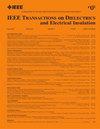AC Pollution Flashover Characteristics on Patterned Hydrophilic-Hydrophobic Surface
IF 2.9
3区 工程技术
Q2 ENGINEERING, ELECTRICAL & ELECTRONIC
IEEE Transactions on Dielectrics and Electrical Insulation
Pub Date : 2025-01-06
DOI:10.1109/TDEI.2025.3526082
引用次数: 0
Abstract
Applying room temperature vulcanizing (RTV) coating on the surfaces of glass and ceramic insulators is a widely employed strategy for antipollution flashover. RTV coating peeling off is the most prominent problem during operation. This study designs an RTV infused regular circular indentations embedded coating structure (ECS). This structure enhances the coating’s adhesion per unit area, thereby reducing the probability of peeling off. To investigate the feasibility of ECS application in outdoor insulation, this article conducts comprehensive hydrophobicity tests and artificial pollution tests. The findings reveal that the polluted ECS exhibits overall hydrophobicity, and its antipollution performance is 4.5% higher than that of RTV. Furthermore, this article discusses the ECS’s pollution flashover mechanism. In the initial stage, according to the FEA model of ECS’s pollution layer, the nonuniform electrical stress and current density are the reasons why ECS forms multiple dry bands. Meanwhile, multiple dry bands induce multiarcs properties similar to those of RTV surfaces. For the arc development stage, this article proposes a model for multiarcs development applicable to hydrophobic surfaces. Calculation results show that the minimum current required for ECS’s nearby arcs merging is 3.5% higher than that of RTV. Hence, the probability of developing from multiarcs to the complete flashover is lower. In summary, ECS holds the potential to become a new insulator structure, offering a long-term solution to pollution flashover issues.图案化亲疏水表面的交流污染闪络特性
在玻璃和陶瓷绝缘子表面涂覆室温硫化(RTV)涂层是一种广泛采用的抗污闪络策略。RTV涂层剥落是生产过程中最突出的问题。本研究设计了RTV注入的规则圆形压痕嵌入涂层结构(ECS)。这种结构提高了涂层的单位面积附着力,从而减少了剥离的可能性。为了探讨ECS在室外保温中的可行性,本文进行了综合疏水性试验和人工污染试验。结果表明,污染后的ECS具有整体疏水性,其抗污染性能比RTV提高4.5%。此外,本文还讨论了ECS的污染闪络机理。在初始阶段,根据ECS污染层的有限元模型,电应力和电流密度不均匀是导致ECS形成多个干带的原因。同时,多个干燥带诱导出与RTV表面相似的多弧特性。在弧发展阶段,本文提出了一个适用于疏水表面的多弧发展模型。计算结果表明,ECS近弧合并所需的最小电流比RTV高3.5%。因此,从多弧发展到完全闪络的概率较低。总之,ECS有潜力成为一种新的绝缘子结构,为污染闪络问题提供长期解决方案。
本文章由计算机程序翻译,如有差异,请以英文原文为准。
求助全文
约1分钟内获得全文
求助全文
来源期刊
CiteScore
6.00
自引率
22.60%
发文量
309
审稿时长
5.2 months
期刊介绍:
Topics that are concerned with dielectric phenomena and measurements, with development and characterization of gaseous, vacuum, liquid and solid electrical insulating materials and systems; and with utilization of these materials in circuits and systems under condition of use.

 求助内容:
求助内容: 应助结果提醒方式:
应助结果提醒方式:


